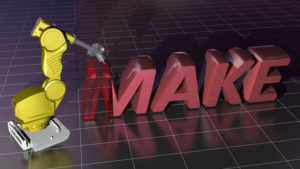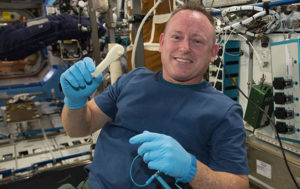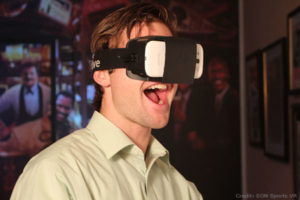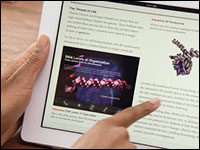
Despite some impressive showings in robotics lately, the accolades are slow to come from industry outsiders. We, the general public, watch Honda’s Asimo slowly make its way down a few steps, for example, and unfairly compare it to the glib and golden C-3PO of science fiction, and thus blind ourselves to the miracle before us.
But it’s not just Asimo that suffers from this prejudice; it’s all of them walking, scrambling or rolling on the planet today.
In that misguided and erroneous judgment of all real robots, there is “Danger, Will Robinson,” as the Model B-9 Environmental Control Robot in “Lost in Space” would say. For ignorance and diminished enthusiasm leads to lack of funding, derailed projects, slowed progress, and fewer minds focused on bringing sci-fi technology to life.
Fortunately, the industry has not been deterred. Once the blinders come off, you see robotics at work everywhere.
Don’t Miss the Revolution
“If you are looking for robots, you might miss the robotic revolution,” Matt Mason, director of the Robotics Institute at Carnegie Mellon University, told TechNewsWorld.
He says a robot is a bunch of technologies all packed together in one human- or animal-sized bundle. But in most cases there is no reason to cram the technologies into such a tight bundle. So even though you don’t see it, robotics technologies are having a significant impact already, and that impact is growing.
For example, computer vision technology is being deployed in cameras for improved auto-focus and red eye correction. It’s also deployed on the Web to assist in image database searches. Robotics technologies are used in computer games, to produce computer generated animation for movies, and even to provide real-time enhancement of televised sporting events.
Serendipitous Design
Where did these robotic enhancements come from? “These are useful by-products we discover along the way,” Oussama Khatib, professor of Computer Science at Stanford University, told TechNewsWorld. Khatib heads a research group at the Stanford Artificial Intelligence Laboratory and is part of Honda’s Humanoid Robot Project. He is also the father of the famous earlier robots: Romeo and Juliet.
“We are making progress on building a humanoid robot, but we don’t need to completely build one before we can apply what we have learned to other disciplines,” explained Khatib.
From enhanced medical tools and procedures to energy-saving appliances and smart security systems, robotics is pushing advancements overall at a speedier pace.
“There is still a long way to go before we see robots that can perform at a level that Hollywood presents, but things are moving ahead enough that there is value emerging,” Tandy Trower, general manager of Microsoft Robotics Group, told TechNewsWorld.
“Techniques like vision recognition that 10 years ago were black arts are popping up all over the place. What would likely cost you thousands of dollars in the past might even be free today,” he added.
Better Living Through Robots
Beyond the invisible but useful robotics that power much of our mundane world, the quest for a perfect robot to aid in an uncertain future is under way in earnest.
In Japan, for example, a think tank is predicting that robots will start to fill the jobs of humans as the population there ages and shrinks. The U.S. is facing a similar population problem, as are a number of other well-developed countries.
“In the U.S. alone, 40 million people are over the age of 65, and over 90 percent of them wish to remain living independently. However, we all know that as we age, our physical and cognitive capabilities tend to decline. Robots could be important way to deal with this by acting as active agents that help make up for any diminished abilities we have,” said Trower.
When industry insiders speak of robots filling jobs, they are not referring to the industrial robots we have now that deliver repetitive and automated services. They are referring to robots that can replace humans in far more complex tasks.
“Robots can remind us to take our medication. Robots can carry things for us. Robots can keep us better connected with our families and caregivers. Robots can even entertain us,” said Trower. “And the cost of the robots to do this will be far cheaper than human assisted care.”
The Robots of Japan
Japan in particular has a reason to rush robot development, which is why we see so many efforts coming from there. “With declines in birth rates, overall the average age is increasing at an unprecedented rate, and it is proceeding most rapidly in Japan,” said Trower.
“There is great concern about how to deal with the loss out of the workforce as well as how to care for an ever increasing population of senior citizens. Robots are seen as way to bridge the gap,” he explained.
The elderly stand to gain a great deal in quality of life issues. “Intelligent homes can provide support to the elderly, allowing us to lead independent lives much longer than we do now,” explained Mason.
That support can range from carrying the groceries and putting them away to cleaning the house, aiding in dressing, providing immediate CPR and summoning medical assistance if needed. The possibilities are endless, making the robotic creations in the movie “I, Robot” a lot less far-fetched.
Humanoid, Insectoid, Robotoid
However, the ultimate design of these synthetic helpers is still a bit up for grabs.
Many have noted that the Japanese tend to design robots that look human while Westerners tend to build robots that look more like insects or animals. What’s up with that?
“This may be partly cultural. The Japanese have always considered robots as positive human assistants. Astro Boy has been one of the earliest, most popular characterizations,” explained Trower. “Perhaps it also has something to do with Asian culture being more attuned with nature, whereas in Western cultures we have been dominated by the scientific method, which tends to separate the rational from the emotional or social aspects of perception.”
Others in the industry think the East vs. West perception of robots is totally off the mark from the start.
“Most of our robots are neither humanoid nor insectoid,” laughed Mason. “In fact, they don’t look like robots at all. Perhaps we should say they are not even robotoid.”
He cites, for example, Boss, the Carnegie Mellon robot that recently won the Urban Challenge that looks like a car. “Probably when we have developed homes with embedded robotic technology, they will still look like homes,” he said.
Challenges Ahead
The challenges ahead are difficult, but multi-disciplined teams are chiseling away at them every day.
“The current robots are platforms to study, but they are not yet safe for human interaction,” explained Khatib. “We are also making progress in sensing and perceiving the environment, but it is difficult. The environment in industry is structured, but the environment around humans is messy. There is still a ways to go.”
Khatib said the major challenges are in integration, decreasing the robot’s weight, making a more sensitive skin for better environment perception, and in solving the human safety issue.
“A major stumbling block is to build systems that are safe and soft enough to interact with people, and also cheap enough for people to afford,” agreed Mason.
In the end, the perfect robot will become commonplace and as unappreciated as the desktop PC.
“Robots are a natural evolution of PC technology, just enabled to interact and support us in a greater diversity of ways,” said Trower. “They will help us live safer and more comfortable lives and will come in many forms, from smarter cars to smarter appliances.
“We may not even think of all of them as robots at all,” he said. At least that much will stay the same.





















































